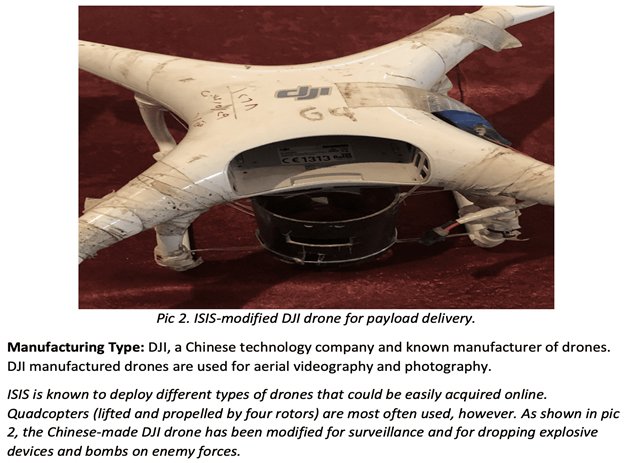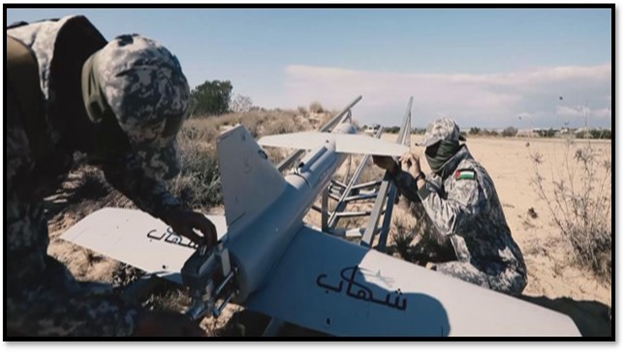In July 2010, the U.S. Defense Intelligence Agency (DIA) intercepted electronic communications indicating that senior Al-Qaeda leaders had distributed a “strategy guide” to operatives around the world advising them how “to anticipate and defeat” unmanned aircraft. Al-Qaeda was sponsoring simultaneous research projects to develop jammers to interfere with GPS signals and infrared tags that drone operators rely on to pinpoint missile targets.
Other projects included the development of small radio-controlled aircraft, or hobby planes, which insurgents apparently saw as having potential for monitoring the flight patterns of U.S. drones. That same year, the CIA noted in a report that Al-Qaeda was placing special emphasis on the recruitment of technicians with expertise in drones technology.[1]
The Islamic State in Iraq and al-Sham (ISIS) and other violent non-state actors, used the technology available on the consumer market to build or purchase small drones modified into “killer bees” capable of creating significant damage and terrorizing civilian and military populations. Drones can be used in various ways: surveillance, strategic communication, transportation (smuggling), disruption of events, complementing other activities or as a weapon.[2]
The first recorded successful attack by terrorists using drones was in mid-2013 when Hezbollah reportedly dropped two small explosive devices on Syrian rebel strongholds using a drone supplied by Iran.[3]
In 2015, Kurdish fighters in Syria shot down multiple small commercial drones laden with explosives, belonging to ISIS.
In 2016, ISIS announced the establishment of the “Unmanned Aircraft of the Mujahideen” unit whose purpose was to engineer UASs for the group to deploy in combat. During coalition forces operations to regain Mosul in June 2017, ISIS flew more than 100 drones against frontline forces every month.[4]
Al-Qaeda has taken inspiration from these events. It planned to use drones to take down airliners using explosive-laden drones at airports in the US and the UK.
In most cases, ISIS used DIY “do it yourself” techniques to combine high- and low-tech components purchased from various connections across Asia and Europe. The program appears to have been shaped by two Bangladeshi brothers who recruited other operatives to work alongside them. They created a series of shell companies to acquire consumer drones from manufacturers in Asia, the US, and Canada. They would then use other shell companies to purchase components such as cameras and GPS units before activating them in the US or Europe. While the eventual capture of one brother and killing of another in a drone strike dramatically dismantled this network, the terror group was still able to obtain drones through other connections.[5]
As jihadis began using drones, they also began to share technology with each other – including technology they obtained from U.S. drones.[6]
Sunni jihadists
ISIS reportedly began using drones in its terrorist activities from 2013 in Syria and Iraq, for spreading propaganda, reconnaissance and attacks. In August 2014, it uploaded propaganda images on the internet of aerial shots taken of bases of hostile forces in Raqqa, in northern Syria, which was its first public display of using drones. From 2016 to 2017, it loaded bombs onto drones and dropped them from the air in successive attacks. As ISIS-controlled areas were scaled down in Syria and Iraq, opportunities for drone usage also decreased; however, drones were discovered in hideouts of ISIS fighters in Iraq in September 2019.
Jihadi discussions about drones on social media, websites, and forums include topics such as: planning attacks on U.S. drone bases, hacking drones, modifying commercially available drones, building homemade drones, and developing methods to disrupt and down Western and rival jihadi groups’ drones, and more.
The commercial drones used by Islamic State have weighed about 50 pounds or less. In addition to using drones with full-motion video to look for attack opportunities and to monitor Iraqi Security Forces, the pilotless aircraft are being used to provide target information for vehicles carrying suicide bombs.
In October 2014 the leading English-language ISIS disseminator Twitter account ShamiWitness tweeted a link to a PDF file titled “The Beginner’s Guide to Multicopters,” which provides instruction on how to build entry-level multi-rotor drones.
In 2016, the Al-Qaeda-affiliated Uyghur anti-China jihadi group Turkestan Islamic Party (TIP) released videos documenting the group’s assault on grain silos northwest of Hama, in Syria, footage for recon and documentation of the battle, and remote-controlled car bombs. One video featured drone footage showing a suicide attack carried out by a TIP fighter against enemy forces in an apartment complex that killed “40 Iranians.”
In 2016, a pro-Al-Qaeda in the Arabian Peninsula (AQAP) Telegram channel posted a list of 17 suggestions for lone-wolf attacks during the upcoming 2016 Summer Olympics in Rio de Janeiro, Brazil. The post suggested attacks attaching small explosives to toy drones,
Boko Haram, which is active in Nigeria and nearby countries, used drones in its attacks against the security forces, and “Al-Qaeda in the Arabian Peninsula” (AQAP) supporters used the internet to call on the group to carry out similar attacks as the one targeting the Saudi Arabian oil facilities in September 2019.[7]
See some of the captured arsenal of ISIS manufactured drones, both weaponized and non-weaponized, used against Iraqi enemy forces.[8]


Shia and pro-Iranian jihadists[9]
In December 2009, the Iran-backed Iraqi militants had hacked into video feeds of American Predator and Shadow drones and passed what they found on to Hezbollah. This was a precedent for Iran’s provision of drones and drone technology to Hezbollah for use in Syria and to the Shi’ite Houthi rebels in Yemen.
In a March 2017, Hashem Al-Mousawi, spokesman for the Iran-backed Iraqi Shi’ite militia Al-Nujaba, highlighted the militia’s activities in Iraq and Syria. Published images show that the militia is operating Iranian drones.
“We are working day and night to develop drones that can be put together in a living room,” said Abu Alaa al-Walai, the leader of Kataib Sayyid al-Shuhada, an Iranian-controlled Shiite militia in Iraq.[10]
Hezbollah
Iran reportedly provided the Hezbollah with drone components and taught its militants how to fly UAVs remotely. Hezbollah initially used its UAVs exclusively to spy on and attack Israel. But Hezbollah expanded its drone operations into Syria when it joined the civil war on the side of President Bashar al Assad in 2012.
Hezbollah’s first flight of an unmanned aerial vehicle into Israeli airspace (a Mirsad-1 drone, an updated version of the early Iranian Mohajer drone) for reconnaissance purposes occurred in November 2004. It hovered over the Western Galilee town of Nahariya for about 20 minutes and then returned to Lebanon before the Israeli air force could intercept it.[11]
Hezbollah launched in August 2006, during the Second Lebanon War, three small Ababil drones into Israel each carrying a 40-50-kilogram explosive warhead intended for bombing strategic targets. This time Israeli F-16s shot them down, one on the outskirts of Haifa.
The next appearance of a Hezbollah drone on October 6, 2012, was a foray that took Israel by surprise. An Iranian drone called “Ayub” flew south from Lebanon over the Mediterranean and into Israel via the Gaza Strip, moving westward about 35 miles into the Negev and penetrating to a point near the town of Dimona, the site of Israel’s nuclear complex. There it was shot down over a forest by Israeli aircraft.
A video released in August 2016 by a Hezbollah-affiliated media outlet appeared to confirm that Hezbollah is using attack drones dropping Chinese-made MZD-2 cluster bombs on three Syrian rebel positions outside Aleppo, in support of the regime of Syrian President Bashar Al-Assad. Hezbollah has claimed to have this capacity since September 2014.
Hamas and the Palestinian Islamic Jihad
Hamas’s drone program has existed since 2012, but the Gaza-based militants have one of the smaller and less advanced arsenals compared with Iran’s other proxies. Its drones have been constructed using local materials. Hamas has used its drones to surveil Israeli sites; it launched kamikaze-style drone attacks on Israel in 2014, 2018, 2019 and 2021.[12]
The Hamas drone program faced two major setbacks. The first was an Israeli airstrike that hit eight Hamas drone storage facilities. The second setback was the assassination of Mohammed Zawahri, a leading Hamas drone engineer, in December in Tunisia. Hamas blamed Israel for the attack and acknowledged that Zawahri had designed drones for its military wing, the Al Qassam Brigades.
After the 2014 Israeli Operation Protective Edge in Gaza, Hamas established an air unit to operate spy drones. In May 2018, it launched at least three drones carrying explosives toward Israel: one landed in the Negev and two landed in the front lawn of a house near the Gaza border. in 2019, Hamas launched at least four separate drone attacks against Israel.
In May 2021, during the latest conflict with Israel, Hamas unveiled a new suicide drone, the Shehab, similar to the Iranian Ababil-T drone although smaller in wingspan. It can hover near its target and explode near it or on impact. It was the “first instance of a precision-guided munition in Gaza,” said Fabian Hinz, an arms expert. In a propaganda video, Hamas displayed at least four Shehab drones.[13]

A Shehab suicide drone unveiled by Hamas in May 2021
During the May 2021 Operation Guardian of the Walls, an Israeli F-16 fighter jet with a Python-5 air-to-air missile downed one Hamas drone, and an Iron Dome system intercepted another, a first for the platform. In total, Israel has intercepted all six Hamas fired drones, using multiple countermeasures including “classified means”.[14]
The Palestinian Islamic Jihad terrorist group released in May 2019 footage purporting to show a drone controlled by its operatives dropping improvised incendiary bombs on an Israel Defense Forces tank stationed on the border with Israel. The footage is filmed from a camera mounted to the drone as well as a long-range lens on the ground in Gaza filming the tank. The tank appears unscathed by the relatively small blasts.[15]
In April 2019, Israel announced that it had foiled an attempt to smuggle 172 mailed packages containing military equipment, including commercial drones, into the Gaza Strip via the Erez Crossing from Israel.
The threat of CBW attacks with drones
Over 25 years ago, the Japanese terror group/cult Aum Shinrikyo considered using drones to distribute sarin gas against civilian populations.
EU Security Commissioner Julian King warned in August 2019, that “drones are becoming more and more powerful and smarter, which makes them more and more attractive for hostile acts.” According to Germany’s die Welt—which published King’s comments—in December 2018, France’s Anti-Terrorism Unit (UCLAT) issued a “secret report” for the country’s Special Committee on Terrorism which warned of “a possible terrorist attack on a football stadium by means of an unmanned drone that could be equipped with biological warfare agents.”[16]
In 2017, Gilles de Kerchove, the European Union’s counterterrorism coordinator, warned that homegrown jihadis could use drones in Europe to drop biological weapons on crowded public spaces. “Someone could process a virus in a cloud lab, take a drone and use a GPS geolocation system to steer the drone, and go to a football stadium to spread the virus created and kill 50,000 people. So, my point is that we need to properly assess every possible threat that these new disruptive techs might pose.”[17]
Conclusion
Small drone attacks on critical infrastructure and personnel from Lebanon to Yemen have demonstrated how conventional air defenses, built to intercept high speed missiles or identify other airborne threats such as aircraft, are incapable of detecting smaller intruders.
Although most of the known incidents and attacks took place outside Europe, it seems that most of the drones used by the Sunni jihadist organizations were bought on the open market by the existing network of jihadists in the West.
Moreover, the members of jihadist groups and supporters were instructed how to purchase, to improve or even construct such drones by themselves and “lone-wolves” were encouraged to used them against civil targets in the Western countries.
Therefore, it can be evaluated that part of this knowledge is already in the hands of jihadist individuals and the videos disseminated in the past by the various organizations give motivation for their emulation in the urban environment in Europe. This threat is enhanced by some of the foreign fighters returnees to Europe and elsewhere, who possibly were involved on the ground in Syria, Iraq, or Libya in drone operations.
The situation is different concerning the Shia pro-Iranian organizations, the ones which have the advantage of being supported by a rogue regime using indiscriminate terrorism worldwide and very much involved in developing drone technologies. The Hezbollah, Hamas and PIJ, and the Houthis are already active actors in this field, for the moment only on the battlegrounds in the Middle East.
[1] Craig Whitlock and Barton Gellman, “U.S. documents detail al-Qaeda’s efforts to fight back against drones,” The Washington Post, September 3, 2013
[2] Thomas Braun and edited by Alexander Fleiss, “Miniature Menace: The Threat of Weaponized Drone Use by Violent Non-state Actors,” Wild Blue Yonder Online Journal, Official United States Air Force Website, September 14, 2020, at https://www.airuniversity.af.edu/Wild-Blue-Yonder/Article-Display/Article/2344151/miniature-menace-the-threat-of-weaponized-drone-use-by-violent-non-state-actors/
[3] Adiv Sterman, “Hezbollah Drones Wreak Havoc on Syrian Rebel Bases.” The Times of Israel, 21 Sept. 2014, www.timesofisrael.com/hezbollah-drones-wreak-havoc-on-syrian-rebel-bases.
[4] Thomas Braun and Alexander Fleiss, Miniature Menace.
[5] Ibid.
[6] Steven Stalinsky and R. Sosnow, “A Decade Of Jihadi Organizations’ Use Of Drones – From Early Experiments By Hizbullah, Hamas, And Al-Qaeda To Emerging National Security Crisis For The West As ISIS Launches First Attack Drones,” Inquiry & Analysis Series No. 1300, MEMRI, February 21, 2017, https://www.memri.org/reports/decade-jihadi-organizations-use-drones-%E2%80%93-early-experiments-hizbullah-hamas-and-al-qaeda#
[7] Review and Prospects of Internal and External Situations, Public Security Intelligence Agency Report, Japan, January 2020, p. 44.
[8] Anne Speckhard and Ardian Shajkovc, “Terrorists’ Use of Drones Promises to Extend Beyond Caliphate Battles,” Homeland Security Today, March 5, 2019, at ihttps://www.hstoday.us/subject-matter-areas/counterterrorism/terrorists-use-of-drones-promises-to-extend-beyond-caliphate-battles/
[9] Steven Stalinsky and R. Sosnow, A Decade of Jihadi Organizations’ Use of Drones.
[10] Paul Iddon, “Experts: Radicals May Soon Be Able to Use Drones for Terrorist Attacks on the West,” European Eye on Radicalization, April 10, 2020, at https://eeradicalization.com/experts-radicals-may-soon-be-able-to-use-drones-for-terrorist-attacks-on-the-west/
[11] Milton Hoenig, “Hezbollah and the Use of Drones as a Weapon of Terrorism,” FAS Public Interest Report, Spring 2014, Vol. 67, No. 2.
[12] Andrew Hanna, “Iran’s Drone Transfers to Proxies,” The Iran Primer, United States Institute for Peace, June 30, 2021.
[13] Ibid.
[14] Seth J. Frantzman, “Iron Dome intercepts drone during combat for first time, says Israeli military,” DefenseNews, May 17, 2021.
[15] “Islamic Jihad releases footage claiming to be drone attack on IDF tank,” Times of Israel, May 30, 2019.
[16] Zak Doffman, “Warning Over Terrorist Attacks Using Drones Given by EU Security Chief, Forbes, August 9, 2019.
[17] “A View From the CT Foxhole: Gilles de Kerchove, European Union (EU) Counter-Terrorism Coordinator,” CTC Sentinel, August 2020, Vol. 13, ISSUE 8.




